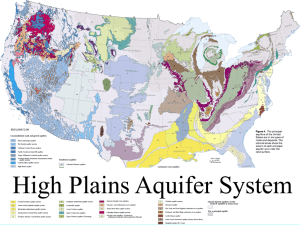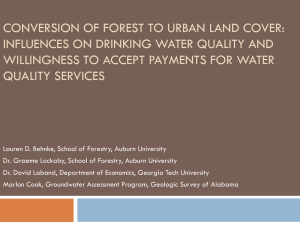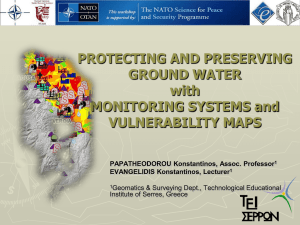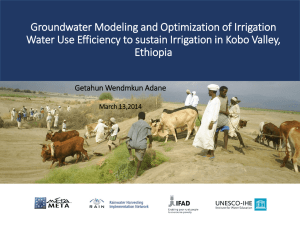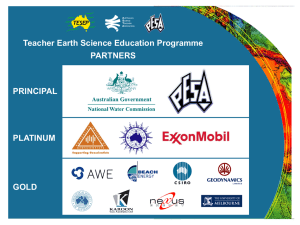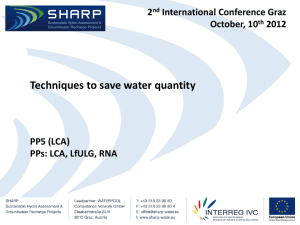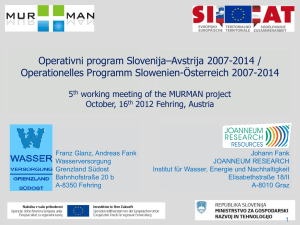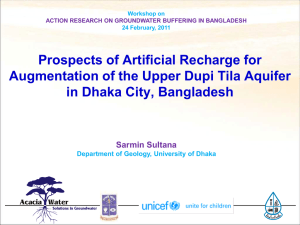RRWPI_SWFWMD_Reclaimed_Water_for_Recharge_rev2
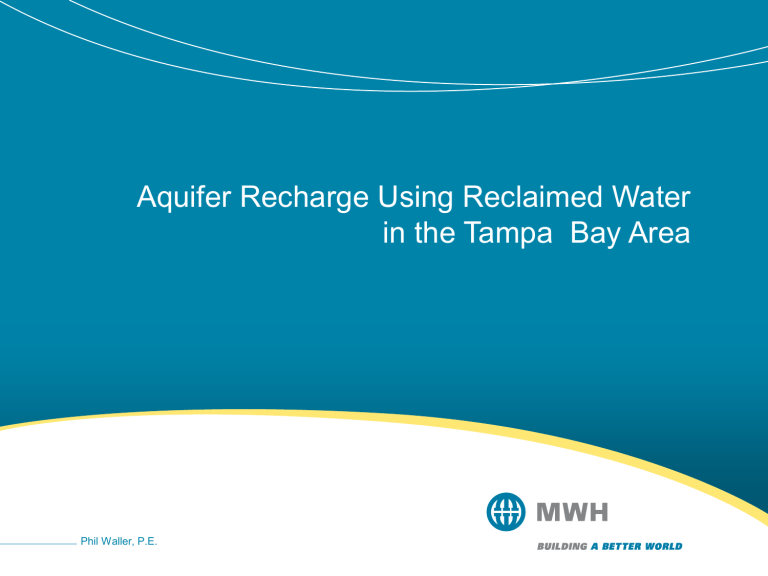
Aquifer Recharge Using Reclaimed Water in the Tampa Bay Area
Phil Waller, P.E.
Project Overview – SWUCA and MIA
Project Scope of Work
• Technical Memorandum 1- Hydrogeology, Water
Quality and Permitting
– Previous Project Review
– Regulatory Review
– Reclaimed Water Quality
– Hydrogeology and Aquifer Water Quality
– Indirect Aquifer Recharge Feasibility Mapping
– Permitted Groundwater Users
– Aquifer Contamination Site Review
– Evaluate Indirect Recharge Technology Issues
– Evaluate Direct Recharge Technology Issues
Project Scope of Work
• TM 2- Water Level Improvements/Impacts
– SWFWMD Rule Summary
– Direct Recharge Groundwater Modeling
– Indirect Recharge Groundwater Modeling
• TM 3- Economic Analyses
• Final Report
Project Schedule
Summary of Similar Projects
• 75 reclaimed water recharge projects were identified globally
• Projects were identified by:
– Reclaimed water as recharge source water
– Groundwater credits or exchange
– Wastewater treatment processes
– Ultimate recharge purpose
• Groundwater level mitigation
• Groundwater replacement
• Salinity barriers
• Long term storage
• Indirect potable reuse
Summary of 16 Relevant Projects
Indirect Recharge Projects
• Water Conserv II RIBs - Orange County and the City of Orlando
• Old Winter Garden Road South WRF RIBs - Orange County Utilities
• Beardsley Road and Butler Drive WRF RIBs - City of Peoria, AZ
• Tucson Sweetwater Wetlands and RIBs - Tucson Water, AZ
• Oak Hill Estates RIBs - Polk County Utilities
• Lake Marden Recharge Project w/wetland - Orange County Utilities
• Project RENEW Irrigation – Orlando Utilities Commission
• Wetlands-Based Water Reclamation Project - City of West Palm Beach
• Orlando Easterly Wetlands - City of Orlando
• Green Cay Wetlands - Palm Beach County Water Utilities Department
Summary of 16 Relevant Projects
Combined Indirect and Direct Recharge Projects
• Arrowhead Ranch Recharge Facility ASR System, Vadose wells, and RIBs - City of Glendale, AZ
• GW Replenishment District RIBs and Salinity Barrier - Orange Co
Water District, CA
Direct Recharge Projects
• Kanapaha WRF Injection Well - Gainesville Regional Utilities, FL
• West Basin Reclamation Project Salinity Barrier - West Basin
Municipal Water District, CA
• Hueco Bolson Recharge Project Recharge Wells - El Paso Water
Utilities, TX
• Bolivar Reclaimed Water ASR System - Adelaide Water Works,
South Australia
Conclusions Derived from Projects
Florida - Reclaimed water has been used for groundwater exchange:
– SJRWMD and SFWMD have approved projects for permitted groundwater exchanges
– Level of treatment predominantly is secondary treatment with filtration and high level disinfection
– Providing reuse water for irrigation to minimize surficial aquifer pumping for irrigation
– RIBs that recharge the surficial aquifer to offset future surficial aquifer withdrawal impacts
– RIBs that recharge the surficial aquifer to restore/mitigate wetlands from Floridan withdrawals
– Wetland recharge where excess wetland sheetflow water can be used for surface water supply augmentation
Conclusions Derived from Projects
Arizona Groundwater Recharge
– Arizona Water Banking Authority established in 1980 to restore basin groundwater supply with Colorado River surface water and reclaimed water
– Deep unconfined aquifer and recharged reclaimed water undergoes Soil Aquifer Treatment
– Reclaimed water meets reuse and AWT standards
– RIBs, Vadose wells, wetlands, and injection wells are used
– Wetland restoration and treatment
– Groundwater recharge for intentional recovery by drinking water wells
– Long term storage credits to be used for withdrawal during drought conditions
Conclusions Derived from Projects
California Groundwater Recharge
– Colorado River is a major component of water imported to Southern
California. River allocations are being reduced due to low river flows.
– California uses reclaimed water for salinity barriers and aquifer recharge for water supply well withdrawal (Groundwater
Replenishment Project, West Basin Reclamation Project)
– RIBs and injection wells are used
– Reclaimed water meets Full treatment standards
• Membranes (multiple barriers)
• UV disinfection
• AOP (hydrogen peroxide)
– Groundwater recharge for intentional recovery by drinking water wells.
– Recharged water retention time is a minimum of 6 months before being captured by drinking water wells
Applicable Aquifer Recharge Regulations
• 62-4, FAC – Permits
• 62-40, FAC – Water Resource Implementation Rule
• 62-520, FAC – Ground Water Classes, Standards, and Exemptions
• 62-521, FAC – Wellhead Protection Rule
• 62-522, FAC – Groundwater Permitting and Monitoring Requirements
• 62-528, FAC – Underground Injection Control
• 62-532, FAC – Water Well Permitting and Construction Requirements
• 62-550, FAC – Drinking Water Standards, Monitoring, and Reporting
• 62-600, FAC – Domestic Wastewater Facilities
• 62-601, FAC – Domestic Wastewater Treatment Plant Monitoring
• 62-610, FAC – Reuse of Reclaimed Water and Land Application
• 62-611, FAC – Wetlands Application
• 62-620, FAC – Wastewater Facility and Activities Permitting
• 62-621, FAC – Generic Permits
– 62-621.500(2)(b), FAC – Generic Permit for Rapid Infiltration Basins
Groundwater Recharge Treatment and
Disinfection Requirements
Type of
Recharge
System
Injection to G-II in the Floridan aquifer or
Biscayne aquifer
(<500 mg/L TDS)
Injection to G-I, F-
I, G-II (<3000 mg/L TDS)
Required Treatment Level Comments and Applicable
Rules
Secondary treatment & filtration
TOC: The lesser of 5 mg/L average or background; 9 mg/L max
TOX: 0.2 mg/L average, 0.3 mg/L max.
TN: 10 mg/L (average)
Drinking water standards and HLD
Multiple barriers (for organics & pathogens)
Mutagenicity testing approved by FDEP.
Activated carbon adsorption or approved alternative.
Full scale operational testing for 2 years.
Approved standby disposal or storage facilities.
Additional pollutant reduction for parameters reasonably expected to pose a risk to public health due to acute or chronic toxicity ( Rule 62-610.562(3)(b), FAC ).
Secondary treatment & filtration
TOC: 3 mg/L average, 5 mg/L max.
TOX: 0.2 mg/L average, 0.3 mg/L max.
TN: 10 mg/L (average)
Drinking water standards and HLD
Multiple barriers (for organics & pathogens)
Pilot testing for 1 year.
Additional pollutant reduction for parameters reasonably expected to pose a risk to public health due to acute or chronic toxicity ( Rule 62-610.562(3)(b), FAC ).
Rule 62-600.540(3), FAC .
Rule 62-520.420, FAC at a minimum.
Possible pilot testing reductions are outlined in
Rule 62-610.564(5), FAC .
ERC will hold a public meeting following pilot testing or full scale operational testing.
Full-scale operational testing complete and national expert review before any permit is issued.
Alternate TOC and TOX limits can be obtained if all public supply wells within 1 mile are owned by applicant, and other users are prohibited or have RO treatment in place ( Rule
62-610.563(3), FAC ).
Possible pilot testing reductions are outlined in
Rule 62-610.564(5), FAC .
Groundwater Recharge Treatment and
Disinfection Requirements (continued)
Type of
Recharge
System
Required Treatment Level Comments and Applicable
Rules
ASR using G-I, F-I,
G-II (<3000 mg/L
TDS)
Secondary treatment & filtration
TOC: 3 mg/L average, 5 mg/L max.
TOX: 0.2 mg/L average, 0.3 mg/L max.
TN: 10 mg/L average
DWSs and HLD
Multiple barriers (for organics & pathogens)
Injection for salinity
Barriers (G-II having
TDS 1000-3000 mg/L
& not used for potable purposes)
Secondary treatment & filtration
Primary DWSs and drinking water disinfection
ZOD for secondary DWSs
TN: 10 mg/L average)
1000 ft. setback from potable supply wells
Lesser standards (principal treatment; see
>3000 mg/L below) if applicant can demonstrate that the groundwater is between
1,000 and 3,000 mg/L, not currently used as a source of public water supply and is not reasonably expected to serve as a future source of public water supply. Secondary
DWSs, TN limit, and HLD fecal coliform standards shall not apply in this case.
( Rule 62-610.466(9), FAC ).
Recovered water must demonstrate standards for BOD5 (20 mg/L), TSS (5 mg/L), and FC
(absence).
Treatment requirements are consistent with injection to G-II having TDS > 3000 mg/L.
Groundwater Recharge Treatment and
Disinfection Requirements (continued)
Comments and Applicable
Rules
Type of
Recharge
System
Required Treatment Level
Part IV systems
(e.g., RIBs) in unfavorable conditions such as highly karstic or over-lying public water supplies
Secondary treatment & filtration
Primary and secondary DWSs and HLD
TN: 10 mg/L average
Rule 62-610.525, FAC .
Also applies to RIBs with loading rates
>9”/day.
Projects are considered as reuse for groundwater recharge.
Allows ZOD for secondary DWSs with affirmative demonstration ( Rule 62-
610.525(8)(b), FAC ).
Discharge to wetlands that percolate to ground water
Wetlands discharges are regulated under Chapter
62-611, FAC
Percolation can be regulated under ground water rules.
Chapter 62-611, FAC .
RIBs and other rapid-rate systems with favorable conditions
Secondary treatment (BOD5 and TSS <20 mg/L)
Basic disinfection (FC <200 cfu/100 mL; CR >0.5 mg/L)
Nitrate: 12 mg/L (max. as N).
Demonstration of <10 mg/L nitrate at edge of
ZOD may allow nitrate limit of 12 mg/L to be waived ( Rule 62-610.510(1), FAC ).
Projects Ranked by Permitting Difficulty
• Projects ranked from simplest to most complex
– Direct recharge or ASR into a G-IV aquifer containing greater than
10,000 mg/L TDS
– RIBs located in areas without direct connection to the Floridan aquifer with no potable water supply expected in the underlying aquifer
– RIBs located in areas with direct connection to the Floridan aquifer and with potable water supply occurring or expected to occur from underlying aquifers in the project area
– ASR completed into an aquifer containing between 3,000 and 10,000 mg/L TDS
– ASR completed into an aquifer containing between 1,000 and 3,000 mg/L TDS that are not reasonably considered to be used for public water supply
Projects Ranked by Permitting Difficulty
• Projects ranked from simplest to most complex (continued)
– Direct recharge into an aquifer containing between 3,000 and 10,000 mg/L TDS (e.g., salinity barriers)
– ASR in an aquifer containing less than 1,000 mg/L TDS
– Direct recharge into an aquifer containing between 500 and 3,000 mg/L TDS
– Direct recharge into an aquifer containing less than 500 mg/L TDS
• More complex permitting projects generally require more stringent water quality standards
SWFWMD Groundwater Permitting
• Minimum aquifer level in most impacted area of the
Southern Water Use Caution Area
• Net Benefit concept
• Other regulatory requirements
Level of Treatment from Area Utilities
• Hillsborough County - Advanced Wastewater Treatment
– Falkenburg AWTP
– Valrico AWT
– South County AWTP
• City of Tampa - Advanced Wastewater Treatment
– Howard F. Curren AWTF
• City of Plant City- Advanced Wastewater Treatment
– Plant City Water Reclamation Facility
• Polk County - Secondary Treatment
– Many WTFs (11 in all)
• City of Lakeland - Secondary Treatment
– Northside WWTP
– Glendale WWTP
Direct Recharge Project Areas
Direct Recharge Projects – 40 MGD Coastal Scenario
Direct Recharge Projects – 40 MGD Coastal Scenario
Direct Recharge Projects – Model Summary Table
Old
Scenario
#
New
Scenario
#
Recharge
Area
Recharge
Rate
(MGD)
1-2
1-1
1-3
1-1
1-2
1-3
1
1
1
10
20
40
Well
Spacing
(Feet)
Model
Simulation
Completed
2,500
2,500
2,500
X
X
X
MIA Monitor
Wells Average
Water Level
Change
(Feet)
2.04
3.48
4.74
2-3
2-1
2-2
2-4
3-2
3-1
3-3
4-2
4-1
4-3
2-1
2-2a
2-2b
2-3
3-1
3-2
3-3
4-1
4-2
4-3
2
2
2
2
3
3
3
4
4
4
10
20
20
40
10
20
40
10
20
40
2,500
2,500
5,000
2,500
2,500
2,500
2,500
2,500
2,500
2,500
X
X
X
X
X
X
X
X
X
X
1.12
2.51
2.25
4.62
0.77
1.77
3.62
0.32
0.67
1.43
MIA Area
Average Water
Level Change
(Feet)
1.08
2.23
3.57
Peace River
Monitor Well
Average Water
Level Change
(Feet)
0.17
0.33
0.45
0.96
N/A
N/A
4.32
0.79
1.77
3.74
0.29
0.66
1.39
0.29
0.61
0.59
1.21
0.38
0.76
1.51
0.76
1.52
3.08
Peace River
Area Water
Level Change
(Feet)
0.38
0.75
1.49
0.82
1.63
3.26
0.17
0.32
0.43
0.28
N/A
N/A
1.17
Direct Recharge Projects - Withdrawals
Floridan Aquifer Vulnerability Assessment
• Evidential Theme (data layer)
– IAS thickness
– Hydraulic head difference (UFA-SAS)
– Proximity to karst features
– Soil permeability
• Training points (occurrence)
– Wells with WQ data indicative of vulnerability
• Response Theme (output map)
– Model output of relative vulnerability
FAVA Evidential Themes
Soil Permeability
Proximity to
Karst Features
Intermediate Aquifer
System Thickness
SAS-FA Head Difference
Model Output = Relative Vulnerability
FAVA Response Theme – Floridan Aquifer
• An output map of the probability of vulnerability
• Calculated by estimating the combined weights of the data layers
• Output theme is displayed in classes of relative vulnerability (one area is more vulnerable than another)
Floridan Aquifer Favorability Assessment
Indirect Recharge Next Steps
• The Lakeland and Lake Wales Ridges in the north may be sites of interest for indirect recharge.
• Availability of land will affect the selection of sites.
• Potential opportunities to use mining lands as recharge sites
• Conduct groundwater modeling on selected sites
Indirect Recharge Site Selection
Recharge Feasibility Next Steps
• Technical Memorandum 2 will summarize numerical groundwater modeling of recharge and withdrawal to quantify the net aquifer benefits to the Upper Floridan aquifer.
• Evaluations will be made to rank the recharge scenarios based on the improvements in water level and the additional withdrawal available to be captured.
• Technical Memorandum 3 will summarize estimated costs for projects that are identified to have a greater aquifer improvement and additional groundwater availability.
• Final report summarizing findings on study.
Phil Waller, P.E.
Aquifer Recharge Using Reclaimed Water in the Tampa Bay Area
The End

